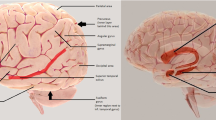Abstract
Logopenic primary progressive aphasia is an atypical variant of Alzheimer’s disease characterized by decreased rate of spontaneous language production. PET/MR imaging demonstrates cortical atrophy and corresponding hypometabolism, typically most severe in the left lateral temporoparietal region.
Access provided by CONRICYT-eBooks. Download chapter PDF
Similar content being viewed by others
Keywords
History
An 80-year-old male with progressive memory loss over 3 years dominated by word finding difficulties, slow speech, and alexia (Fig. 122.1). Patient unable to repeat complete sentences.
Diagnosis
Logopenic primary progressive aphasia
Findings
-
MPRAGE and FLAIR images show mild global atrophy which is more severe in the left parietal lobe (wide arrows).
-
PET surface rendering lateral view images show severe left parietal and left posterior temporal lobe hypometabolism (curved arrow), which is less severe on the right side.
-
PET surface rendering view of the medial right hemisphere demonstrates decreased FDG activity in the right precuneus (thin arrow).
Discussion
Logopenic primary progressive aphasia (lvPPA) is often considered as an atypical variant of Alzheimer’s disease (AD) characterized by decreased rate of spontaneous language production. The term logopenic is from Greek meaning “lack of words.” The disease can be thought of as a more asymmetric or “language variant” AD at initial presentation. In primary progressive aphasias, like lvPPA, language impairment should be almost the exclusive symptom for the first 1–2 years of the dementia syndrome. Initially, there should be little or no memory impairment. Histology studies show most patients with lvPPA have underlying Alzheimer’s pathology.
This dementia subtype shows similarity to AD that is demonstrated by increased PET amyloid radiotracer activity in the brain, and increased amyloid beta peptides (Aβ42) and tau in CSF . Early in disease development patients demonstrate length-dependent impaired sentence repetition, phonological errors, alexia, and anomia. As the dementia progresses, the disease overlaps with other primary progressive aphasia variants. In the late stages of the disease, patients develop apraxia, semantic memory deficits, and jargon aphasia. Preservation of single word comprehension helps to distinguish logopenic aphasia from semantic variant of primary progressive aphasia.
Imaging findings for lvPPA on FDG PET/MRI show characteristic decreased metabolic activity in the temporal lobe, parietal lobe, and posterior cingulate gyrus with accompanied cortical volume loss on MRI similar to Alzheimer’s disease. Areas of hypometabolism correspond well to areas of cortical atrophy. The area of the most severe decreased FDG uptake and cortical atrophy is in the left lateral temporoparietal region which is associated with repetition and phonological clinical defects. This is likely where the pathology initially appears before spreading to other areas of the brain.
Suggested Reading
Henry ML, Gorno-Tempini ML. The logopenic variant of primary progressive aphasia. Curr Opin Neurol. 2010;23(6):633–7.
Leyton CE, Villemagne VL, Savage S, Pike KE, Ballard KJ, Piguet O, et al. Subtypes of progressive aphasia: application of the international consensus criteria and validation using β-amyloid imaging. Brain. 2011;134:3030–43.
Madhavan A, Whitwell JL, Weigand SD, Duffy JR, Strand EA, Machulda MM, et al. FDG PET and MRI in logopenic primary progressive aphasia versus dementia of the Alzheimer's type. PLoS One. 2013;8(4):e62471.
Author information
Authors and Affiliations
Corresponding author
Rights and permissions
Copyright information
© 2018 Springer International Publishing AG
About this chapter
Cite this chapter
Hoch, M.J., Bangiyev, L., Shepherd, T.M. (2018). Logopenic Primary Progressive Aphasia. In: PET/MR Imaging . Springer, Cham. https://doi.org/10.1007/978-3-319-65106-4_122
Download citation
DOI: https://doi.org/10.1007/978-3-319-65106-4_122
Published:
Publisher Name: Springer, Cham
Print ISBN: 978-3-319-65105-7
Online ISBN: 978-3-319-65106-4
eBook Packages: MedicineMedicine (R0)





